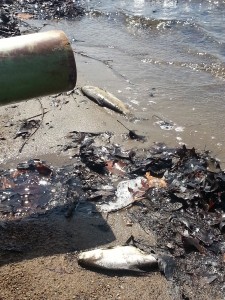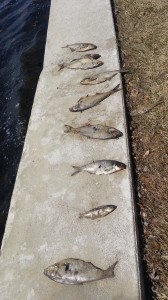UPDATE: Fish Kills Possible This Spring

Dead fish can be seen around the shores of Winona Lake and have been reported at other surrounding lakes and ponds in the county.
(Photo by Alyssa Richardson)
[UPDATE: As reported on March 19, due to the constant ice cover on lakes depleting oxygen levels for aquatic life, fish kills have been reported throughout the county. Readers have noted quantities of dead fish at Pike Lake, Winona Lake and Ridlinger Lake.
Though gizzard shad has been the primary species to suffer from the winter conditions, readers have stated seeing dead bass and bluegill in small, residential ponds. Fish kills are expected to be worst and most likely in smaller bodies of water]
As temperatures have begun to climb into the 40s this week, many have begun to set their sights on spring and summer temperatures and days spent enjoying Kosciusko’s many lakes. However, due to the constant ice cover throughout the winter season, lake characteristics may be slightly different than what has been experienced in the past few years.
According to the Center for Lakes and Streams Director Nate Bosch, due to the constant frozen conditions of lakes, this year could show some extremes.
“Constant ice cover for so many days reduces evaporation from the lakes which keeps lake levels higher going into spring and summer,” stated Bosch. “You may recall the opposite happened in 2012 when warm winter temperatures kept the lakes open and losing water even before the drought that spring and summer. ”
Though many in the area who dealt with the effects of low lake levels in the summer of 2012 may consider the constant freeze a good thing, it may affect factors beyond lake levels, namely the local fish and aquatic population.
“This ice cover also stops oxygen from getting into water during winter months such that fish can run out of oxygen. I have already seen fish kills this year, in fact, as I have been sampling outflowing streams from local lakes,” explained Bosch. “Once the lake ice opens up across the county, we will likely see many dead fish.”
Bosch is not alone in this expectation, according to the Indiana Department of Natural Resources, owners of shallow ponds and lakes, especially in northern Indiana, are warned to watch for fish kills this spring.
The DNR reports that due to the near-record snowfall and ice up, to 20 inches thick on lakes and ponds, Indiana fisheries biologists have also noted numerous reports of fish kills.

These fish, which were strangely lined up in a row, were found along the shore of Winona Lake.
“Aquatic plants can produce oxygen only when sunlight is available. While some sunlight can penetrate clear ice, snow can block sunlight, resulting in dangerously low oxygen levels,” explained the DNR in a press release. “Shallow, weedy ponds are more susceptible to winter kills. As aquatic plants naturally die during winter, plant decomposition consumes oxygen that fish and other aquatic life need. Once a winter kill begins, little can be done to stop it. Drilling holes in the ice will not help.”
The DNR reports that biologist are not currently expecting major fish kills at deep, natural lakes and reservoirs outside of gizzard shad, a species that is vulnerable to prolonged cold weather. Though there is a higher chance of shad fish kills, the DNR and Bosch both report it is unlikely that the “prolific and fast growing” species will experience any lasting decline in populations.
According to Bosch, though the lake temperatures are set to be colder this spring and early summer, a warm summer could warm waters up to their usual temperatures. Bosch noted that, though he is not an expert on insects in the area, he believes there will not be as big of an impact on insect populations as fish.
Lake residents and anglers who observe significant fish kills on public waters should contact their district fisheries biologist. Contact information is in the 2014 Fishing Regulation Guide or at wildlife.IN.gov/3590.htm. For further information on area lake conditions and the possibility of fish kills in the area, visit the Center for Lakes and Streams’ newsletter HERE.
